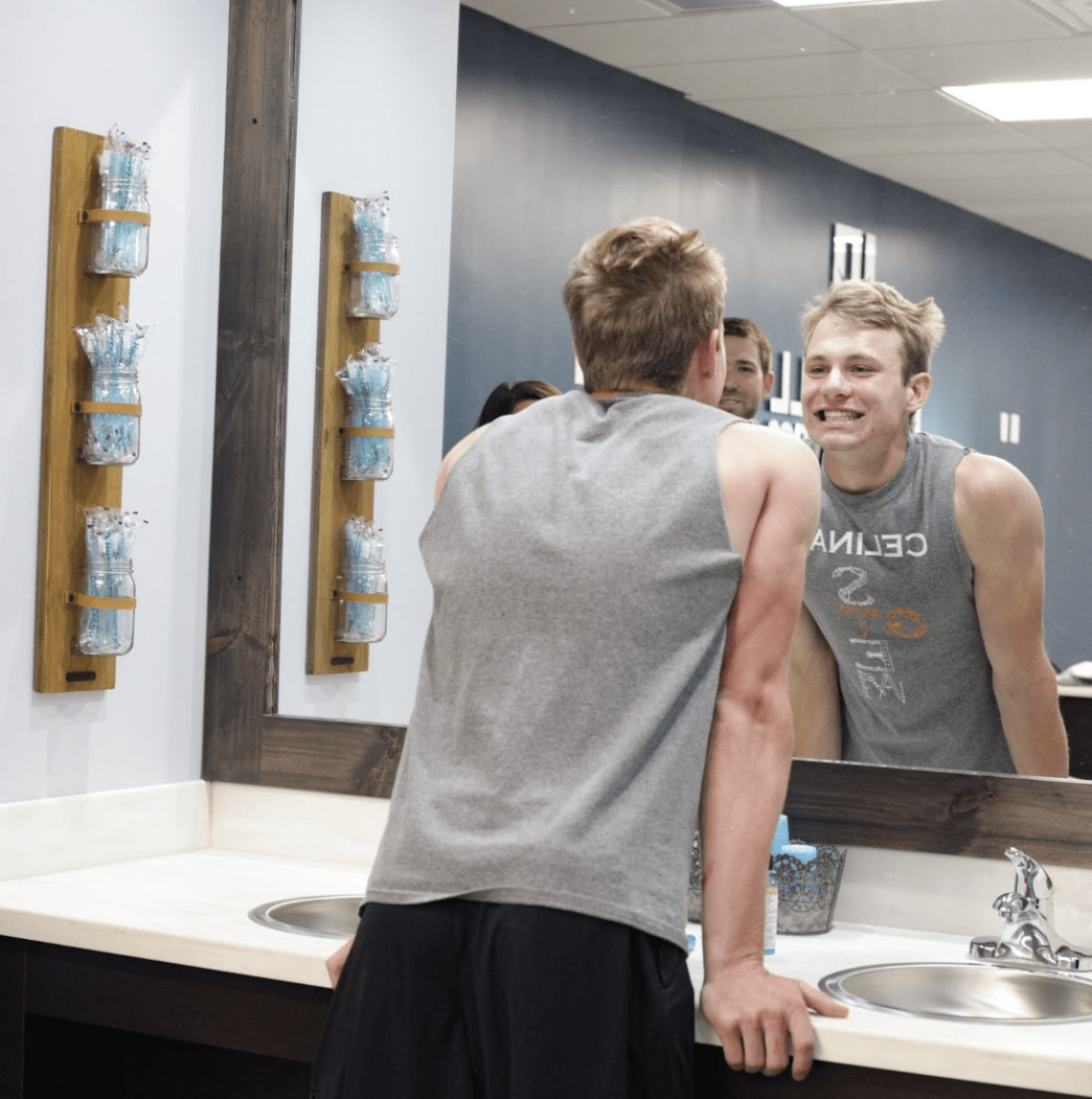Sports offer a variety of exciting benefits for kids, from education to developing social skills to teaching life lessons to just plain fun! While your young superstars are out on the field, you want to make sure their goal-scoring smiles are safe. If your child has braces, a retainer, or clear aligners, they need protection to avoid injuries and permanent mouth damage.
Hemphill Orthodontics wants to keep your kids safe and on the field or court. Our team is prepared for any emergency your athlete may experience. Whether it’s cut lips or broken appliances from sports-related injuries, we want to be their pit stop. The solution for many sports-related injuries can be as simple as using the right protective gear.
Sports and Dental Injuries
Here’s something to consider: 40% of all dental injuries in the United States are sports-related. Mouth injuries are often expected in sports with lots of high-speed contact and collision. However, accidents can happen regardless of what game the athletes are playing. A fall during a solo sport like skateboarding or track can result in a broken bracket or chipped tooth.
Young athletes who visit our office at Hemphill Orthodontics can continue to play sports even during treatment. That being said, it’s important to check your child’s appliances immediately if they have an accident while playing. If the appliances look damaged or their teeth are loose or falling, schedule an appointment for repair as soon as possible.
Our primary goal is to give your child a quick assessment and provide early treatment. The most common injuries our orthodontists see are tooth fractures, also referred to as “chipped tooth.” We also see soft tissue lacerations or cuts on the gums, tongue, or cheeks due to direct impact to or with the area. As we check for these types of injuries, we examine the motion of your child’s jaw to address any jaw dislocation. Some patients may experience more severe oral health injuries. A tooth can be displaced but still in the socket or even an avulsion in which the tooth becomes wholly dislocated.
Sports-Related Oral Protection
According to the American Association of Orthodontists, 99% of parents with children playing organized sports believe mouthguards should be required to participate. Despite this, close to 40% of those parents say their children never wear one while playing.
If your child isn’t used to wearing a mouthguard, it can be tricky to help them get into the habit of keeping it on during a game. Still, it’s one of the more inexpensive ways to protect your child’s teeth, tongue, gums, and cheeks from trauma during athletic activities.
Orofacial injuries are a risk for participants of all ages, genders, and athletic skill levels. Whether it’s organized and unorganized sports, at recreational and competitive levels, at school, or in kids’ leagues. While most dental injuries are sustained during collision and contact sports, they are prevalent in limited-contact, non-contact, and high-velocity activities.
The American Dental Association recommends the use of a properly fitting mouthguard in the following activities:
Contact/Collision Sports
- Basketball
- Boxing
- Combat Sports
- Football
- Handball
- Hockey (Ice and Field)
- Lacrosse
- Martial Arts
- Rugby
- Soccer
- Water Polo
- Wrestling
Limited Contact and Other Sports
- Acrobatics
- Baseball
- Bicycling
- Equestrian Events
- Field Events
- Gymnastics
- Inline Skating
- Racquetball
- Shot-Putting
- Skateboarding

Choosing Your Mouthguard
There are many different options for mouthguards. According to the ADA Council of Scientific Affairs and Council on Advocacy for Access and Prevention, an ideal mouthguard should:
- Stay in place comfortably and securely
- Be adequately fitted to the wearer’s mouth and accurately adapted to their oral structures
- Be made of material approved by the FDA and cover all remaining teeth on one arch
- Be physiologically compatible with the wearer
- Be easy to clean
- Have high-impact energy absorption to reduce or limit transmitted forces upon impact
If your child is receiving orthodontic treatment, speak with one of our orthodontists to ensure the mouthguard will fit over their appliances and not damage the device or harm their mouth if impact occurs.
Your child will know they have a good fit if it feels comfortable, offers full coverage, and doesn’t interfere with speaking or breathing. The three most common types of mouthguards are stock (also called “pre-made”), custom-made, and mouth-formed.
Stock Mouthguards
This option is the most common mouthguard due to availability. You are likely to find it in a sporting goods store. These mouthguards come in various sizes and colors to suit as many wearers as possible. However, the stock mouthguard is considered the least effective option. This is because it has a generic design that may not fit every child’s mouth. This gives it an improper fit and requires the mouth to be shut to keep it in place. They are also called “pre-made” mouthguards.
Mouth-formed Mouthguards
Also called “boil-and-bite,” these mouthguards are warmed in water to become permeable and then cooled slightly. Once they’ve cooled, they’re placed in the mouth and bitten down onto creating a customized fitting. These can be usually found in sporting goods stores or online. A dental professional can help facilitate the proper forming of dental appliances. Follow all manufacturer’s instructions precisely to ensure adequate heating and molding of the thermoplastic material, and avoid improper shaping creating a poorly fitted device with diminished protection.
Custom-made Mouthguards
Custom mouthguards are made in an orthodontic lab from individual patient impressions. Our orthodontists make them using thermoforming techniques to make them fully customized and provide wearers with the best fit to adapt to their mouth. This is often the most expensive option for oral protection. However, the balanced occlusion and maximized tooth contact significantly reduce the risk of the mouthguard becoming displaced while playing sports.
Orthodontic Emergencies
When your child has their first sports-related dental injury, we want you to be prepared. The experience is often scarier than the reality of it, and there are ways you can be ready! Remember to stay calm and carefully examine and take note of the damage to be explained to the dental professional. Contact Dr. Hemphill for specific instructions on mitigating your injury until he sees you in the office. Here are some of the more common injuries we see and how to handle them best.
Fractured Tooth
To stabilize the broken or chipped tooth and control any bleeding, your child can bite gently on a towel as you take them to the dentist. If the tooth comes out of their mouth completely, it can be transported in milk, under their tongue, or wrapped in saline-soaked gauze.
Missing Tooth
If the whole tooth has come out of the socket, do not touch the roots. Pick the tooth up by the crown. Gently rinse it in water and place the tooth back into the socket it came from, gently biting down on a towel to hold it in place as you head to the emergency dentist. A tooth placed back into the socket within five minutes of ejection can be saved!
Intruded Tooth
If the tooth looks shorter than usual, it may have been pushed into the bone and become intruded. This is a painful experience and requires an immediate visit to an emergency dentist. Do not attempt to pull the tooth out or reposition the tooth.
Extruded or Laterally Displaced Tooth
This injury will look like a tooth is longer than usual. It often appears with the displaced tooth being pushed back or pulled forward. To reposition this tooth, place firm but precise pressure on it. This process can be painful and is most effectively performed by a dental professional.
These are the most common dental emergencies children have in sports, but they are not all the possibilities. Make sure you get to your dentist as soon as possible after an injury. Your dentist or orthodontist can remedy many mouth injuries caught in the first couple of hours without risk of permanent damage. However, check if your child develops a fever, has trouble breathing or swallowing, or their bleeding doesn’t stop after about ten minutes of pressure. This could be a more serious problem, and you should go to the nearest emergency room.

Trust your smile to the experts at Hemphill Orthodontics
Your smile deserves an expert team, and we want to guide you every step of the way along your smile journey. Whether you’re just getting started on your orthodontic journey or looking for a new office to visit, Hemphill Orthodontics is your location for modern orthodontic treatment. Our office is located in the Celina area, so your orthodontic care is always close to where you live and work. We’d love for you to reach out for your FREE consultation with our team at Hemphill Orthodontics to get started on your personalized journey to a healthy and happy smile.
 972-636-4175
Free Consult
972-636-4175
Free Consult

 Dr. Hemphill
Dr. Hemphill